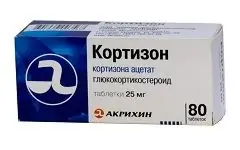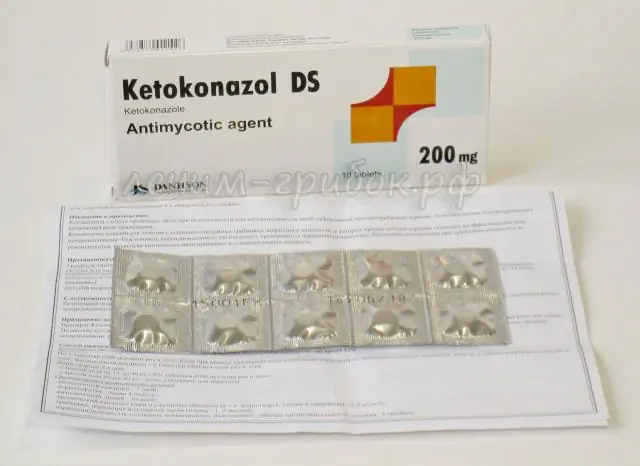- Author Rachel Wainwright [email protected].
- Public 2023-12-15 07:39.
- Last modified 2025-11-02 20:14.
Cortisone
Cortisone: instructions for use and reviews
- 1. Release form and composition
- 2. Pharmacological properties
- 3. Indications for use
- 4. Contraindications
- 5. Method of application and dosage
- 6. Side effects
- 7. Overdose
- 8. Special instructions
- 9. Drug interactions
- 10. Application during pregnancy and lactation
- 11. Use in childhood
- 12. In case of impaired renal function
- 13. For violations of liver function
- 14. Analogs
- 15. Terms and conditions of storage
- 16. Terms of dispensing from pharmacies
- 17. Reviews
- 18. Price in pharmacies
Latin name: Cortisone
ATX code: H02AB10
Active ingredient: cortisone acetate (Cortisone acetate)
Producer: Akrihin JSC (Russia)
Description and photo update: 2019-20-08
Prices in pharmacies: from 940 rubles.
Buy

Cortisone is an oral glucocorticosteroid used for chronic adrenal insufficiency.
Release form and composition
Cortisone is produced in the form of tablets: flat-cylindrical, white with a yellowish tinge or white, with a chamfer (10 pieces in blisters, 8 packages in a cardboard box).
The composition of 1 tablet includes:
- Active ingredient: cortisone acetate - 25 mg;
- Auxiliary components: sugar, potato starch, stearic acid.
Pharmacological properties
Pharmacodynamics
The active ingredient of the drug is cortisone acetate, a biologically inactive substance that is converted in the liver into hydrocortisone, a glucocorticosteroid (GCS), which affects protein, carbohydrate and lipid metabolism. Possessing anti-inflammatory, anti-allergic and immunosuppressive efficacy.
GCS has mineralocorticoid activity (retention of fluid and sodium ions, excretion of potassium ions), but weaker than true mineralocorticoids. It causes an increase in the excretion of nitrogen in the urine, increases the concentration of glucose in the blood, and promotes the accumulation of glycogen in the liver.
The anti-inflammatory effect of Cortisone is due to the ability to inhibit phospholipase A2, as a result of which the synthesis of prostaglandins is inhibited, the release of macrophage chemotactic factor decreases, the migration of lymphocytes and macrophages to the focus of inflammation decreases, lysosomal membranes are stabilized, and the release of lysosomal enzymes is prevented.
The immunosuppressive effect of the drug is associated with its ability to reduce the number of immunocompetent cells, reduce the binding of immunoglobulins to cellular receptors, suppress blast transformation of B-lymphocytes, and also reduce the amount of cytokines, interleukins, circulating immunocomplexes and complement fractions.
Cortisone enhances the excretion of calcium ions in the urine, which activates bone resorption and increases the activity of osteoclasts, but reduces the activity of osteoblasts.
The drug stimulates the liver enzyme systems, thus activating gluconeogenesis. Due to its lipolytic properties, it increases the concentration of fatty acids in the blood. Due to its catabolic action, Cortisone increases protein breakdown. It also reduces the production of adrenocorticotropic hormone by the anterior pituitary gland, due to which the activity of the adrenal cortex is suppressed, followed by its atrophy.
The duration of action of the drug is 6-8 hours.
Pharmacokinetics
After oral administration, cortisone is rapidly and almost completely absorbed in the upper jejunum. With food intake, the absorption rate slows down somewhat, but its degree does not decrease.
The substance reaches its maximum concentration in plasma within 0.5-1.5 hours. It binds to plasma proteins by 90%. First, it undergoes a presystemic metabolism, in which cortisone acetate is converted into active hydrocortisone. Then it is rapidly metabolized in the kidneys, liver and peripheral tissues with the formation of inactive metabolites, excreted mainly by the kidneys.
The half-life (T ½) is approximately 1.5 hours.
Indications for use
According to the instructions, Cortisone is prescribed for chronic adrenal insufficiency (Addison's disease, hypocorticism after bilateral total adrenalectomy, hypopituitarism with secondary hypocorticism, congenital dysfunction of the adrenal cortex) - simultaneously with mineralocorticoids.
Contraindications
The only contraindication for short-term use of Cortisone for health reasons is hypersensitivity to the components of the drug.
Children during the period of growth can be prescribed Cortisone only if there are absolute indications and under the very careful supervision of the attending physician.
The drug should be used with caution in the following diseases / conditions:
- Infectious and parasitic diseases of a viral, bacterial or fungal nature (recent or current, including recent contact with a patient): chickenpox, herpes simplex, herpes zoster (viremic phase), measles, amebiasis, strongyloidosis (suspected or established), systemic mycosis, active or latent tuberculosis (use for severe infectious diseases is possible only against the background of specific antimicrobial therapy);
- Post-vaccination period (a period lasting 8 weeks before and 2 weeks after vaccination), lymphadenitis after BCG vaccination;
- Immunodeficiency states (including acquired immunodeficiency syndrome (AIDS) or HIV infection);
- Diseases of the gastrointestinal tract: gastritis, esophagitis, gastric ulcer and duodenal ulcer, peptic ulcer (latent or acute), ulcerative colitis with the threat of abscess formation or perforation, newly created intestinal anastomosis, diverticulitis;
- Diseases of the cardiovascular system: recent myocardial infarction (in patients with subacute and acute myocardial infarction, the spread of the necrosis focus, slowing of the formation of scar tissue and, as a consequence, rupture of the heart muscle is possible), arterial hypertension, decompensated chronic heart failure, hyperlipidemia;
- Endocrine diseases: diabetes mellitus (including disorders of carbohydrate tolerance), obesity of 3-4 degree, hypothyroidism, thyrotoxicosis, Itsenko-Cushing's disease;
- Severe chronic hepatic and / or renal failure, nephrourolithiasis;
- Hypoalbuminemia and conditions that predispose to its development;
- Systemic osteoporosis, acute psychosis, myasthenia gravis, poliomyelitis (except for the form of bulbar encephalitis), closed and open-angle glaucoma.
Pregnant women (especially in the first trimester) Cortisone tablets can be prescribed only for health reasons. During lactation, breastfeeding is recommended to be interrupted while taking the drug.
Instructions for the use of Cortisone: method and dosage
Cortisone tablets are taken orally.
The usual average maintenance dose for chronic adrenal insufficiency is 25-50 mg per day. The drug is taken in 2 doses, while it is necessary to reproduce the daily rhythm of cortisone secretion: 2/3 of the daily dose at 6-8 am, 1/3 at 17-18 hours. With the threat of stress, the daily rate can be increased by 2-3 times, while increasing the frequency of intake up to 3-4 times a day (after 6-8 hours).
With congenital dysfunction of the adrenal cortex, Cortisone is taken at 25 mg per day along with other glucocorticosteroids (dexamethasone, prednisolone). The maximum adult doses are: single - 150 mg, daily - 300 mg.
For children, the drug is prescribed depending on age. The maximum doses are (single / daily):
- Up to 5 years - 25/75 mg;
- 5-10 years old - 50/150 mg;
- Over 10 years old - 75/225 mg.
If it is necessary to replace Cortisone with other drugs with glucocorticosteroid activity, it should be borne in mind that 25 mg of Cortisone is equivalent in action to:
- Hydrocortisone - 20 mg;
- Prednisone, prednisolone - 5 mg;
- Triamcinolone, methylprednisolone - 4 mg;
- Dexamethasone - 0.75 mg.
Side effects
The frequency of occurrence and severity of side effects are determined by the duration of therapy, the dose and the possibility of observing the circadian rhythm of the appointment.
During the use of Cortisone, the following side effects may occur:
- Digestive system: erosive esophagitis, nausea, pancreatitis, vomiting, "steroid" ulcers of the stomach and duodenum, perforation and bleeding of the gastrointestinal tract, flatulence, decreased or increased appetite, hiccups: in rare cases - an increase in alkaline phosphatase and activity of the liver transaminases;
- Endocrine system: decreased glucose tolerance, inhibition of adrenal function, manifestation of latent diabetes mellitus or "steroid" diabetes mellitus, Itsenko-Cushing's syndrome (hirsutism, moon-like face, amenorrhea, myasthenia gravis, pituitary type obesity, increased blood pressure, dysmenorrhea) delayed sexual development in children;
- Nervous system: convulsions, headache, disorientation, delirium, hallucinations, euphoria, manic-depressive psychosis, paranoia, depression, insomnia, increased intracranial pressure, anxiety or nervousness, dizziness, pseudotumor of the cerebellum, vertigo;
- Cardiovascular system: bradycardia (up to cardiac arrest), arrhythmias, development (in predisposed patients) or increased severity of heart failure, ECG changes characteristic of hypokalemia, hypercoagulation, increased blood pressure, thrombosis; in patients with subacute and acute myocardial infarction - the spread of the focus of necrosis, a slowdown in the rate of formation of scar tissue, which can cause rupture of the heart muscle;
- Musculoskeletal system: slowing down the processes of ossification and growth in children (premature closure of the epiphyseal growth zones), osteoporosis (very rarely - aseptic necrosis of the femoral head and humerus, pathological bone fractures), “steroid” myopathy, rupture of muscle tendons, decreased muscle mass (atrophy);
- Skin and mucous membranes: petechiae, delayed wound healing, ecchymosis, thinning of the skin, hypo- or hyperpigmentation, striae, “steroid” acne, a tendency to develop candidiasis and pyoderma;
- Metabolism: increased sweating, hypocalcemia, increased excretion of calcium ions, negative nitrogen balance (due to increased protein breakdown), increased body weight;
- Sense organs: trophic changes in the cornea, posterior subcapsular cataract, increased intraocular pressure with possible damage to the optic nerve, exophthalmos, a tendency to develop secondary bacterial, viral or fungal eye infections;
- Allergic reactions: generalized (anaphylactic shock, itching, skin rash), local allergic reactions;
- Others: leukocyturia, exacerbation or development of infections (the appearance of these disorders is facilitated by the simultaneous use with immunosuppressants and vaccines), withdrawal syndrome.
Also, during therapy, disorders associated with the mineralocorticoid activity of the drug may occur, manifested in the form of retention of sodium ions and fluid (peripheral edema), hypernatremia, hypokalemic syndrome (arrhythmias, hypokalemia, myalgia or muscle spasm, fatigue and unusual weakness).
Overdose
In case of an overdose, the severity of side effects increases, and symptoms of hypercortisolism may develop. There is no specific antidote to cortisone. Treatment is symptomatic.
special instructions
During the use of Cortisone, it is necessary to monitor the condition of the cornea and intraocular pressure.
Cancellation of the drug Cortisone should be carried out by gradually decreasing the dose (because of the danger of the "withdrawal" syndrome) - the longer the course of treatment, the slower the decrease in the daily dose should be.
During the use of Cortisone, vaccination should not be carried out due to a decrease in its effectiveness (immune response).
With long-term treatment of children, it is necessary to carefully monitor the dynamics of their growth and development.
Children who, during the use of Cortisone, were in contact with patients with chickenpox or measles, prophylactically should be prescribed specific immunoglobulins.
During the period of growth of children, glucocorticosteroids can be used only for absolute indications and under the very careful supervision of the attending physician.
Influence on the ability to drive vehicles and complex mechanisms
Due to the possibility of disorientation, seizures, dizziness, hallucinations, damage to the optic nerve, Cortisone should be taken with caution by patients driving vehicles and performing other potentially hazardous types of work that require increased concentration of attention and fast psychomotor reactions.
Drug interactions
With the simultaneous use of Cortisone with certain drugs, the following undesirable effects may occur:
- Inducers of "liver" microsomal enzymes (rifampicin, phenobarbital, theophylline, phenytoin, rifampicin, ephedrine): decrease in the concentration of Cortisone;
- Diuretics (especially "thiazide" and carbonic anhydrase inhibitors) and amphotericin B: increased excretion of K + from the body;
- Sodium-containing drugs: the occurrence of edema and an increase in blood pressure;
- Amphotericin B: increased risk of heart failure;
- Thyroid hormones: increased clearance of cortisone;
- Cardiac glycosides: a deterioration in their tolerance and an increase in the likelihood of developing ventricular premature beats (due to induced hypokalemia);
- Indirect anticoagulants: weakening (less often - strengthening) of their action (dose adjustment is necessary);
- Anticoagulants and thrombolytics: increased risk of bleeding from ulcers in the gastrointestinal tract;
- Ethanol and non-steroidal anti-inflammatory drugs: increased risk of developing erosive and ulcerative lesions in the gastrointestinal tract and bleeding (in combination with non-steroidal anti-inflammatory drugs during the treatment of arthritis, it is possible to lower the dose of glucocorticosteroids due to the summation of the therapeutic action);
- Paracetamol: an increased risk of hepatotoxicity (formation of a toxic metabolite of paracetamol and induction of liver enzymes);
- Acetylsalicylic acid: accelerating its excretion and lowering the concentration in the blood (when cortisone is canceled, the level of salicylates in the blood and the risk of side effects increase);
- Insulin and oral hypoglycemic drugs, antihypertensive drugs: decrease in their effectiveness;
- Cyclosporine and ketoconazole: Increased cortisone toxicity;
- Vitamin D: a decrease in its effect on the absorption of Ca2 + in the intestine;
- Growth hormone: decrease in its effectiveness;
- Adrenocorticotropic hormone: increasing the action of cortisone;
- Praziquantel: decrease in its concentration;
- M-anticholinergics (including tricyclic antidepressants and antihistamines) and nitrates: increased intraocular pressure;
- Estrogens and oral estrogen-containing contraceptives: a decrease in the clearance of Cortisone, an increase in the severity of its action;
- Isoniazids and mexiletine: an increase in their metabolism (especially in "slow" acetylators) and a decrease in their plasma concentrations;
- Carbonic anhydrase inhibitors and loop diuretics: increased risk of osteoporosis;
- Indomethacin: increased risk of developing its side effects;
- Ergocalciferol and parathyroid hormone: preventing the development of osteopathy caused by cortisone;
- Androgens and steroid anabolic drugs: the development of peripheral edema and hirsutism, the appearance of acne;
- Antithyroid drugs: decreased cortisone clearance;
- Live antiviral vaccines and other types of immunization: an increase in the risk of developing infections and activating viruses;
- Antacids: decreased absorption of cortisone;
- Azathioprine and antipsychotics (neuroleptics): increased risk of developing cataracts.
With simultaneous use with mitotane and other inhibitors of adrenal cortex function, an increase in the dose of cortisone may be required.
Application during pregnancy and lactation
The drug crosses the placental barrier and into breast milk.
During pregnancy (especially in the first trimester) Cortisone can be used only for health reasons, if the expected benefit for the woman is definitely higher than the possible risks to the fetus. With prolonged use of pills during pregnancy, intrauterine growth retardation is possible. There is also a risk of developing adrenal cortex atrophy. In the latter case, after delivery, the newborn requires replacement therapy.
If the course of treatment is necessary during lactation, women should stop breastfeeding.
Pediatric use
For children, Cortisone can only be prescribed if there is an absolute indication. Treatment is carried out under the close supervision of the attending physician, including monitoring of growth and development.
With impaired renal function
The drug should be used with extreme caution in cases of severe renal failure and nephrourolithiasis.
For violations of liver function
Patients with concomitant hepatic impairment during treatment should be under special supervision.
Analogs
Cortisone analogs are Dexazone, Dexamethasone, Kenalog, Cortef, Lemod, Megadexan, Medrol, Metipred, Polcortolone, Prednisolone, Prednisolone Nycomed, etc.
Terms and conditions of storage
Store in a dark, dry place out of reach of children at temperatures up to 25 ° C.
The shelf life is 5 years.
Terms of dispensing from pharmacies
Dispensed by prescription.
Reviews of Cortisone
Reviews of Cortisone, as a drug for the treatment of chronic adrenal insufficiency, are positive. However, many patients complain about the development of side effects.
Price for Cortisone in pharmacies
Depending on the pharmacy chain, the price of Cortisone varies in the range of 905-1030 rubles. per pack of 80 tablets of 25 mg.
Cortisone: prices in online pharmacies
|
Drug name Price Pharmacy |
|
Cortisone tablets 25mg 80 pcs. RUB 940 Buy |
|
Cortisone 0.025 g tablets 80 pcs. RUB 940 Buy |

Anna Kozlova Medical journalist About the author
Education: Rostov State Medical University, specialty "General Medicine".
Information about the drug is generalized, provided for informational purposes only and does not replace the official instructions. Self-medication is hazardous to health!






